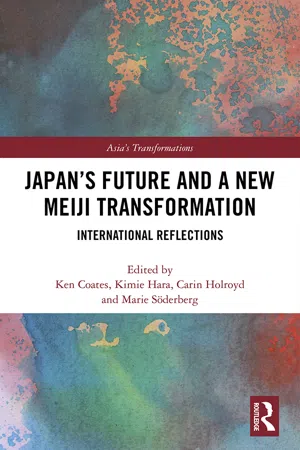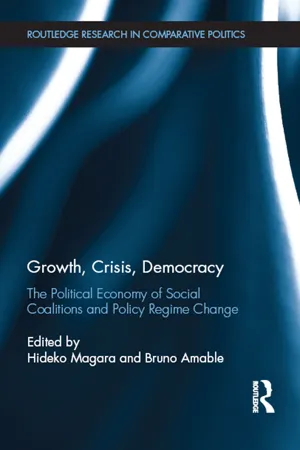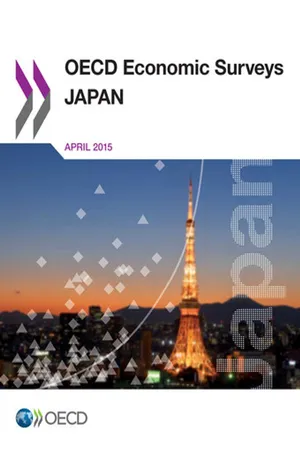Economics
Abenomics
Abenomics refers to the economic policies implemented by Japanese Prime Minister Shinzo Abe, aimed at revitalizing the country's economy. The three main pillars of Abenomics are monetary easing, fiscal stimulus, and structural reforms. The goal is to combat deflation, boost economic growth, and address long-standing issues such as an aging population and low productivity.
Written by Perlego with AI-assistance
Related key terms
6 Key excerpts on "Abenomics"
- eBook - ePub
Japan's Future and a New Meiji Transformation
International Reflections
- Ken Coates, Kimie Hara, Carin Holroyd, Marie Söderberg(Authors)
- 2019(Publication Date)
- Routledge(Publisher)
Part IJapan in a changing world
Security, economics and politics
Passage contains an image
2 New Meiji’s economics and financeIs Abenomics successful and sustainable? Most probably not
Axel Berkofsky
The discussion about the Japanese need for reinvention rests largely on the dissatisfaction and concern about the country’s persistent economic stagnation. Prime Minister Shinzo Abe presented an aggressive “three arrow” economic strategy that he felt would reignite Japanese exports and prosperity. Axel Berkofsky examines the fate of “Abenomics” and argues that the new policies are not likely to be sufficient to overcome almost two decades of underperformance and set to rest concerns about the country’s long-term economic strength.Introduction
“Abenomics” was supposed to provide a “big bang” for Japan’s sluggishly growing economy and return the country to sustainable economic growth rates, when Prime Minister Shinzo Abe announced in 2013 the adoption of his “three arrows” economic, fiscal and financial strategy: first, Abe promised central bank quantitative easing (QE); second, he would provide fiscal stimulus and third, structural reforms. As it has turned out, however, two of these three policies making up “Abenomics”—quantitative easing and fiscal stimulus—look increasingly unsustainable and too costly, possibly doing more harm than good to the Japanese economy in the long term (Matthews, 2015).Today and five years later, the only arrow of “Abenomics” that is arguably able to travel any further is structural reforms. However, many of the structural reforms that Abe promised Japan have yet to be adopted and other structural reforms have not even made it onto Tokyo’s policy agenda. In 2013, it was announced that the Bank of Japan’s (BoJ) monetary easing and the resulting weak yen would increase exports, private investments, and private consumption. This is turn would lead to sustainable inflation (2 percent was and still is the [seemingly unrealistic] target) and an increase in Japanese wages (The Economist - eBook - ePub
Gradual Institutional Change in Japan
Kantei Leadership under the Abe Administration
- Karol Zakowski(Author)
- 2020(Publication Date)
- Routledge(Publisher)
LDP’s electoral victory and the formation of the Abe cabinet in December 2012 signified that Abenomics had become one of the crucial policies of the new government. In his policy speech to the Diet in January 2013, Abe stated that he considered “prolonged deflation and the appreciation of the yen to be shaking from their very base the foundations of trust in society that ‘those who work hard shall be rewarded’” (Prime Minister of Japan and His Cabinet 2013d). As stressed by the prime minister, “It will be impossible for us to break free of deflation and the appreciating yen by dealing with them in ways that are an extension of what we have done thus far” (Prime Minister of Japan and His Cabinet 2013d). For that reason, Abe declared his intention to “press forward with economic revival under the three prongs of bold monetary policy, flexible fiscal policy, and a growth strategy that encourages private sector investment” (Prime Minister of Japan and His Cabinet 2013d).Abenomics was a well-timed initiative. Although it can be perceived as a set of policies proposed by the METI, it fitted Abe’s convictions and was eagerly embraced by him in the electoral campaign. Having learned a bitter lesson under his first administration, Abe needed a policy agenda that would appeal to the voters. The popular support for the “three arrows” and the first signs of economic recovery fueled the decision-making process on implementation of the bold economic plans.Decision-making bodies on Abenomics
The first decision-making bodies on Abenomics were established inside the LDP even before its victory in the parliamentary election. After returning to the post of LDP president, Abe created the LDP Headquarters for Japan’s Economic Revitalization, whose first meeting took place on October 24, 2012. It was chaired by Abe, with his close associates LDP Policy Research Council Chair Amari Akira as deputy chair and Motegi Toshimitsu as secretary-general. METI bureaucrats used this body to exert influence on LDP’s economic policy before the upcoming election. They particularly took advantage of their connection with Amari, who had served as the minister of economy, trade and industry from 2006 to 2008. However, it was Abe himself who put strong pressure on the Headquarters to include such bold policy goals as the 2% inflation target in its mid-term report from mid-November 2012 (Karube 2018: 10–41). - eBook - ePub
- J Mark Munoz(Author)
- 2017(Publication Date)
- Routledge(Publisher)
Japan’s lost decades that followed the 1991 banking crisis were characterised by the lowering of expectations, prices and growth, conditions under which deflationary expectations became self-fulfilling. The crisis, which began with failures of financial institutions and businesses, caused by a high level of speculative investment in property, necessitated the banks assuming major responsibility for various rescue operations and restructuring. To support the economy’s escape from a deflationary spiral, the Bank of Japan (BOJ) launched a series of unconventional monetary policies between 2001–06 and 2010, which failed to revitalise the economy. To put an end once and for all to deflation and no growth, Abe introduced a much broader and more radical set of policies in 2013 with the key objectives of:• Achieving a 2% inflation target via monetary expansion. • Designing a flexible fiscal policy to act as an economic stimulus in the short term, and in the longer run achieving a budget surplus to reduce public debt. • Launching a growth strategy to focus on structural reform and private investment to improve long-term growth.For some, Abenomics represents a monetary regime change similar to that of the USA during the 1930s (Bojkova, 2014). As such, Japan’s current policies and developments under the Abe Cabinet, and their regional and global implications, have attracted much interest amongst Western policymakers.3 Monetary policy—the first arrow of Abenomics
The BOJ has officially used unconventional monetary policies since 2001, and some elements of these since the Great Depression (Bruce & Bojkova, 2014). However, in 2016 it sought to catalyse a bigger and bolder combination of rising prices, higher corporate profits, and increase in wages and employment. The BOJ planned to expand its QQE to maintain the increase of the monetary base at an annual pace of about ¥80 trillion through the purchases of Japanese government bonds, with the provision that purchases could be increased if needed. In addition, from early 2016 the average maturity of the Bank’s Japanese government bonds purchases were extended from 7 to about 7–12 years to encourage a smoother decline in rates across the entire yield curve. Moreover, the Bank will, as well as maintaining its purchases of corporate bonds, purchase exchange-traded funds and Japan real estate investment trusts at an annual rate of about ¥3 trillion and ¥90 billion, respectively (BOJ, 2015). - eBook - ePub
Issues in Global Business
Selections from SAGE Business Researcher
- SAGE Publishing(Author)
- 2021(Publication Date)
- SAGE Publications, Inc(Publisher)
7Abe, who briefly served as Japan’s prime minister in 2006–2007, was elected again in 2012. The ambitious economic program he calls Abenomics seeks to correct the nation’s trade imbalance and end two decades of deflation, as well as address serious demographic issues. The plan’s three prongs, or “arrows,” include monetary easing, fiscal expansion and structural reform.Abe’s first arrow is loose monetary policy. Because Japan’s benchmark interest rate has been at zero for years, that involves what is known as quantitative easing. Japan’s central bank, the Bank of Japan, is buying government securities to pump more money into the economy and thus raise consumer spending and bring about inflation—years of deflation battered the Japanese economy. The bank has gone through two rounds of bond buying, but it has been unable to raise inflation to 2 percent.8DescriptionJapan’s Decades of Weak GrowthNote: Figures for 2015–17 are projections.Sources: Data for 1985–2014 downloaded from the World Bank, http://tinyurl.com/o3z46zw ; estimates for 2015–17 downloaded from the World Bank, http://tinyurl.com/nvbuzwo .The second arrow, expansive fiscal policy, involved $116 billion worth of government spending, including for infrastructure projects designed to repair damage from the catastrophic Great East Japan earthquake of 2011.9 Other government spending goals included expanding foreign trade, investing in renewable energy, promoting research and development, supporting small businesses, improving access to health care and expanding tourism.10DescriptionMap: Major Earthquakes in JapanNote: Points on maps are approximations based on U.S. Geological Survey mapping data.Sources: “Japan’s Biggest Earthquakes,” Live Science, Apr. 8, 2011, http://tinyurl.com/oxcgu5z ; “Earthquake Archives” map tool, U.S. Geological Survey, accessed Sep. 25, 2015, http://tinyurl.com/m4ksz7h - eBook - ePub
Growth, Crisis, Democracy
The Political Economy of Social Coalitions and Policy Regime Change
- Hideko Magara, Bruno Amable(Authors)
- 2017(Publication Date)
- Routledge(Publisher)
3 Abenomics and Japanese politics Masanobu Ido IntroductionIn its beginning, the twenty-first century was believed to be the century of a revived America and global finance capitalism. Although the global economic crisis of 2008 appeared to put this rosy picture into question, we are clearly still living in a world of global finance capitalism. In this “brave new world,” the rise and fall of a national economy are mainly determined by foreign investors (in particular, hedge and pension funds), rating agencies, and international organizations, such as the International Monetary Fund. In today’s globalized world economy, the autonomy of national economic policy is seriously curtailed. Political leaders of all the countries are under the constant pressure of the neoliberal doctrine “Implement neoliberal economic reforms and maintain fiscal discipline, otherwise you cannot survive the global economic competition.” Yet, even if we accept the validity of the neoliberal mantra, can we expect that democratic political leaders, who are accountable to the population, can replace the post-war Keynesian policy regime, which closely linked them to their political supporters, with a neoliberal policy regime? In this study, this question is investigated by examining Abe’s economic revival plan, the so-called “Abenomics.”In the wake of the 2008 global economic crisis, the Democratic Party of Japan (DPJ) took power from the Liberal Democratic Party (LDP) by arguing for a shift in economic policy. However, it ultimately lost public support with its bungled handling of the relocation of the US military base in Okinawa; this led to the strain in US-Japanese relations, its failure in crisis management relating to the Fukushima nuclear disaster after the Great Eastern Japan Earthquake on March 11, 2011, and finally, its internal conflicts and ultimate breakup. In the 2012 general election, with its slogan “Reclaiming Japan,” Abe’s LDP came into power for the first time in three years and nine months. The Abe cabinet quickly put its economic revival program, Abenomics, into practice to rescue Japan from its 20-year economic stagnation, the so-called “Lost Two Decades.” With his Abenomics, is Abe replacing post-war Japan’s Keynesian policy regime – more precisely, its conservative version under the long LDP rule – with a new neoliberal policy regime, or is Abenomics merely a cosmetic upgrade of the old policy regime? The question is whether Abe, a leader of the LDP (comprising the old institution that is strongly linked to Japan’s post-war growth), can realize a neoliberal economic reform that will sacrifice the LDP’s old clients such as the farmers and the construction industry? - eBook - ePub
- OECD(Author)
- 2015(Publication Date)
- OECD(Publisher)
1. Per capita GDP is calculated using 2005 prices and PPP exchange rates. Labour productivity equals GDP per hour of labour input. Labour inputs equal total number of hours worked per capita.2. General government basis as a percentage of GDP. OECD estimates for 2014 and projections for 2015-16.Source: OECD, Going for Growth Database ; OECD Economic Outlook Database .StatLink http://dx.doi.org/10.1787/888933201725In early 2013, Japan launched a three-pillar approach, the so-called three arrows of “Abenomics”, to exit deflation and revitalise the country: a bold monetary policy; flexible fiscal policy; and a growth strategy. The first arrow was launched in early 2013 with the introduction of “quantitative and qualitative easing” (QQE). It was accompanied by the second arrow, which included two large fiscal packages. The third arrow – the Japan Revitalisation Strategy – was announced in June 2013 and revised a year later. The combined effects of fiscal and monetary policy expansion and structural reform were intended to strengthen business investment and private consumption, with a view to boost real growth to a 2% annual pace through 2022 and to achieve a 2% inflation target. The initial results of the first two arrows were encouraging; nominal GDP increased at a faster pace, aided by a pick-up in inflation, reflecting a large depreciation of the yen. Output growth reached 1.6% in 2013, as business and consumer confidence soared and the stock market rose by 57%. Following a contraction in the wake of the consumption tax hike, growth resumed in late 2014.The third arrow of Abenomics is its most crucial component, without which the unprecedented monetary expansion and the fiscal effort will not succeed in putting Japan on a path to faster growth and fiscal sustainability. The ten key reforms in the Strategy include important measures to promote growth, but they need to be more ambitious and implemented rapidly. The top priorities are: i) stabilising the size of the labour force by boosting the participation of women and older people and expanding inflows of foreign workers; ii) enhancing Japan’s integration in the world economy through trade agreements, notably the Trans-Pacific Partnership (TPP) and the Japan-EU Economic Partnership Agreement; and iii) improving the business climate by upgrading corporate governance, enhancing labour flexibility and mobility, promoting venture capital investment and improving policies for small and medium-sized enterprises (SMEs).
Learn about this page
Index pages curate the most relevant extracts from our library of academic textbooks. They’ve been created using an in-house natural language model (NLM), each adding context and meaning to key research topics.





